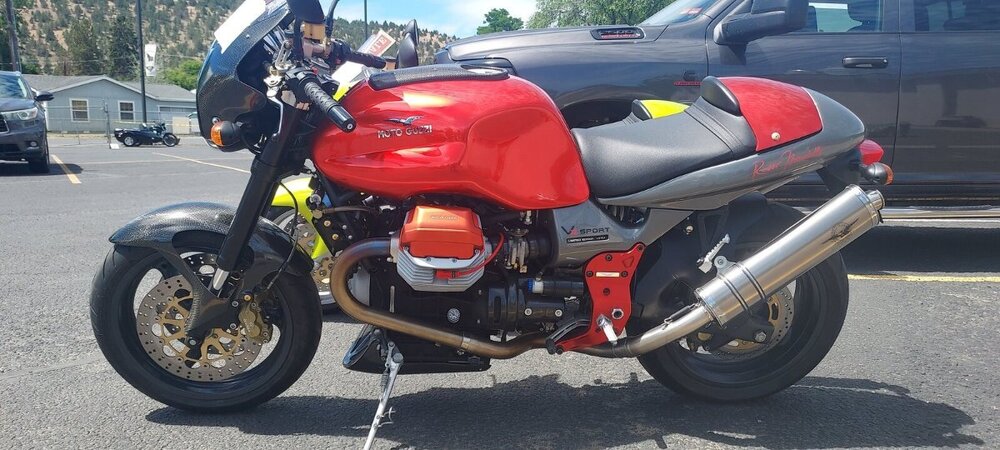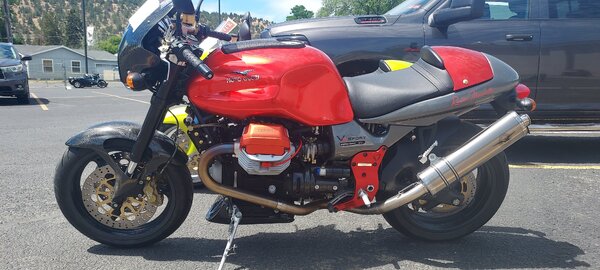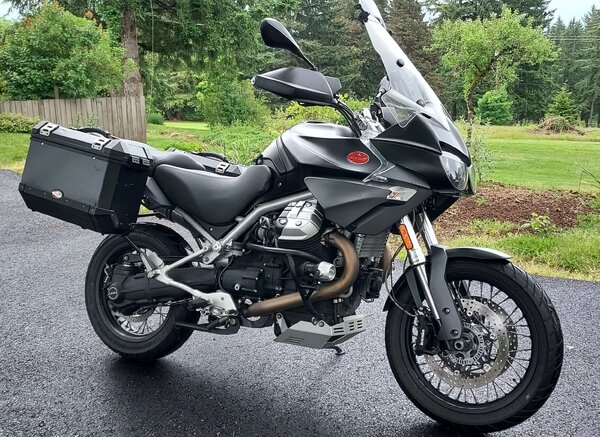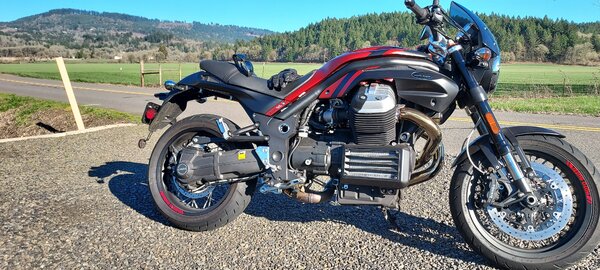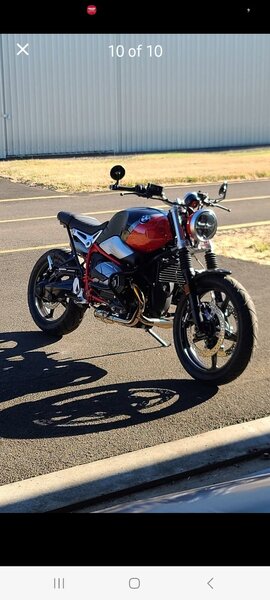All Activity
- Past hour
-
@Sam P, let's try to take the oil pressure light out of the equation. You reported the oil light illuminates when the connector to the switch is grounded. Connect your Ohm meter and measure resistance from the switch post to ground, key off. The switch should be closed/grounded with no oil pressure, resistance = > 0 < = oil light on. If the switch is open with no oil pressure (engine off)/ resistance = > 1 < = no oil light, then the oil pressure switch has failed and has nothing to do with the odd behavior of the "battery/charging" light . . .
-
I reckon the first assumtion was good. Battery cooked = regulator is not doing it's stuff, too many Volts into the battery = dead battery. Been there, done that (more than once... ). In those cases, the battery light didn't come on. I don't know for sure that the battery light never shows overcharging, but I understand it to be that the light generally only comes on when the system is undercharging. In that context, I would question the second assumption. Given that I don't expect the warning light to show overcharging, I wouldn't expect it to come on if the stator is delivering too many volts. Apart from the warning light, the regulator should take care of too many volts. That is, after all, what it is there for. The alternator delivers a voltage that increases with revs. The regulator is supposed to keep that under control and make sure that never more than about 14V gets through to the charging system. Regarding the third point, I've already written that I suspect that there are two problems. From the information that you have provided, it seems that your charging system is currently not working, despite the new regulator and stator. Therefore the charge warning light should be lit up all the time. It isn't, so it is fair to assume that there is also a problem somewhere in the circuit that the warning lamp is in. I'd still like to know what the resistance (Ohm) measurement is between the connector for the warning lamp to the regulator (where the blue wire is connected) to ground. If the regulator is behaving correctly, that should be close to zero with the key on, engine off, "infinite" with the engine running and the charging system working properly, and close to zero if the charging system is not working properly. If that is not the case, the regulator might have a problem, or there might be bad connections somewhere else. If it is the case, the warning light circuit would seem to have a problem that is confusing the issue.
-
"Weird bollocks ", indeed! I have put mySport on the lift, removed the seat, pulled the regulator connector apart, probing with the DVOM, trying to fathom why @Sam P's Sport won't charge and how the strange warning light behavior might inform a solution . . .
-
A few words on this... Basically, I'm of the same opinion as @docc here. Regarding batteries: modern Lithium-ion batteries are much better at not getting a "memory", living with lower charge states and what-have-you. As a sound engineer, I've spent the last 40-odd years dealing with things that run on batteries. Experience shows that it is better to regularly make sure they get charged properly, then let them cycle for a while as the manufacurer intended, then make sure they get a good charge, then let them cycle, and so on. The lead-acid variants that we find in our motorcycles belong to the category that this applies to. Cheap trickle chargers don't do the business. Docc has the right approach: proper charger, let it cycle, proper charger. And now, back to the topic in question: why is your charging system doing weird bollocks?
-
My memory is unfortunately foggy one the chain of events, but I will try to reconstruct them here. After the first Odyssey showed signs of bubbling and bloating - with no alert from the charging lamp - I assumed to regulator was bad, and that the reg was overcharging the battery, hence the bloating. So I replaced the reg, along with my current "new" Odyssey battery. Next, I took the bike for a ride and the battery light lit up again, so I suspected the stator - sending too many AC volts to the regulator - which I then replaced. Installed the new stator, rode for 100 miles and the charging light never lit up. Like an idiot, I thought all my problems were solved, lol. The next ride, the lamp started to activate at 3-4K rpm, which is where we are now. (This was the title of this post, remember? Is the stator defective?' My memory is foggy on this, but I never recall the battery light OR the oil light EVER activating with key on, engine off.
-
The derived protocol takes more attention and involvement, but improves the outcome. Is it worth it? I can say, with certainty, mySport's performance (and reliability) is significantly better with optimal charging and battery strength. YMMV
- Today
-
Good news. Just got an email from batterystuff.com with a UPS tracking # and the charger is scheduled for delivery this Friday. Not to derail my own thread on my charging issue, but it sounds like going forward I should stop using the Battery Tender and use your protocol quoted here, amirite?
-
If I am reading this correctly, the odd charging light behavior started after the battery got cooked. And did not change with the new stator and regulator? Makes me think something also got cooked in the harness/connectors - seemingly in the circuit involving the instrument panel . . .
- Yesterday
-
Exactly. Over time, that low float voltage (below Odyssey's 13.2 minimum threshold) will "shorten battery life". How much? Unknown. But undesirable. Your new charger is likely configured to address this. Rather than the "tender" approach, I have grown fond of charging the Odyssey with at least 6 amps up to 15.0 volts, then float charge at 13.56v (what my EnerSys charger will float) for maybe 24 hours, then terminate charge and let the battery gradually discharge. Repeat when the static charge reaches 12.65v. _____________________________________________________________________________________ > LESS voltage on trickle/float is NOT okay. Odyssey states that floating under 13.2 damages the battery: "Note, however, that the charge voltage should not be dropped below 13.2V as that will cause the battery grids to corrode faster, thereby shortening the battery life."
-
Just went out to the garage - the DMM reads 13.12v with the Battery Tender attached. Close but no cigar?
-
Thanks Phil...very good and educational explanation...I'll try experimenting at the next oil changes on the Norge/Griso/Scura with a viscosity spread of 30...if I can perceive any improvement in performance, "feeling" and / or mileage that would be a bonus.
-
My Ducati 1000ss DS, 1000cc air cooled fuel injected engine with about the same specific output of a Norge, recommended oil 10W-40. My Guzzi 1100 2 valve same as Norge engine basically ran for 10 years on M1 0W-40. Not many road engines are going to "blow up" because of the oil you use or the grade. But when you pull it down for a rebuild it can make the difference between whether or not you have a simple and cost effective re ring and new big end shells and valve guides or the total every wear part needs to be replaced and it's a part out job now expense wise. Then there is giving away performance and fuel economy aspect. Me, I just like to run what I know myself is the best oil for my specific needs and eliminate the corporate "less than ideal but cover all bases" approach no matter how obscure and ridiculous. Phil
-
Pretty sure @Sam P posted the answer to this on page 8 . . .
-
The red/green wire that had a wire nut at the end , did you connect it to anything ?
-
Ha, that makes a lot of sense! Phil
-
The bulb is in this circuit. IDK what r value is for the bulb , BUT i am happy.
-
With the trickle charger connected to the battery, test the voltage across the battery terminals (charge voltage). Most common "trickle chargers" will be below Odyssey's 13.2v minimum threshold.
-
I get 15.9Ω with this same test.
-
Did not start it up. I will do this tomorrow morning and report back. Need to get some better terminal connections for the jumper wire if I am going to fire up the motor.
-
12v/1.25 Amp
-
Did you start it to see if it charges with the jumper wire to the black wire of the regulator? Next, I would jumper the other side of the connector (battery voltage to the white wire and the connector rotated to connect the black --> red/black. I don't think the light will come on at all in that configuration. Looking for the charging voltage to come up while running above idle. . .
-
Good call on getting the approved charger. Odyssey states that float voltage below 13.2v will shorten battery life. What is your trickle charger's voltage?
-
best place to get red valve covers & matte grey frame plates?
activpop replied to fastaussie's topic in 24/7 V11
I've always noticed that the RM's valve covers turn a little more orange over time. Is it the heat that affects the paint, UV rays or both? I don’t think that happens with powder coating, but the sheen might be different. -
I replaced the blistered and bloated Odyssey last month with a new one, just before I started this thread. I've skimmed through your Odyssey Battery Conditioning thread (20+ pages!) and have ordered what I believe is an appropriate charger.(Battery Minder 128CEC2, which I believe replaces the older 12248 model). Will condition my battery asap, but I assume I can continue to troubleshoot my charging issues in the meantime. I am still keeping the battery on my trickle charger, which keeps the volts at 13-13.4, and I hope this isn't hurting the battery.








